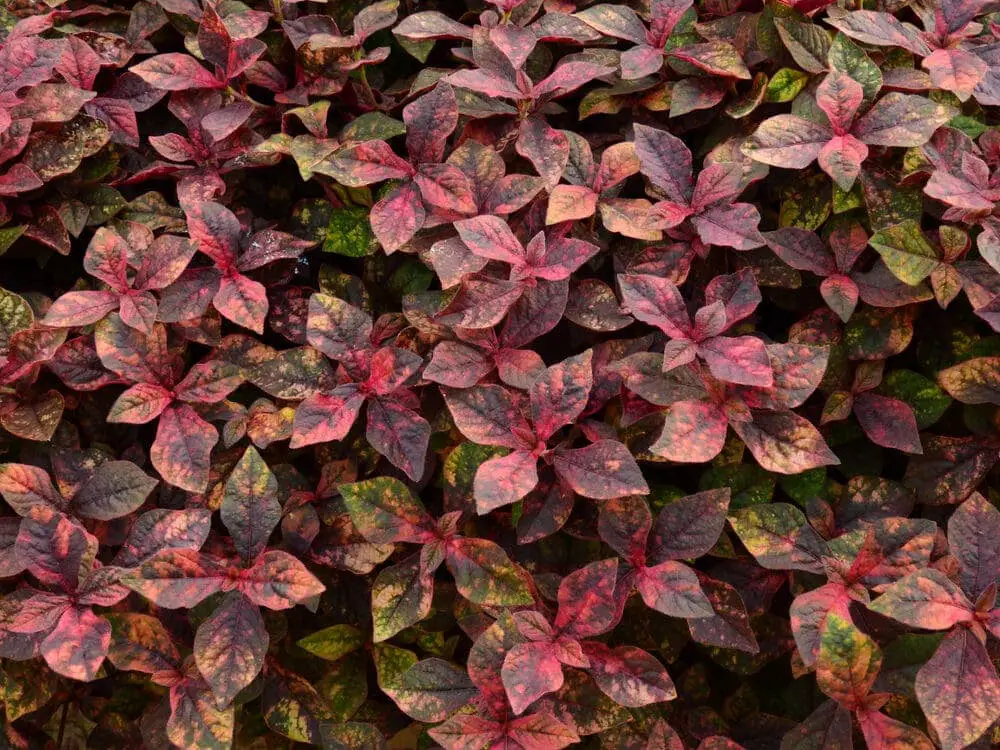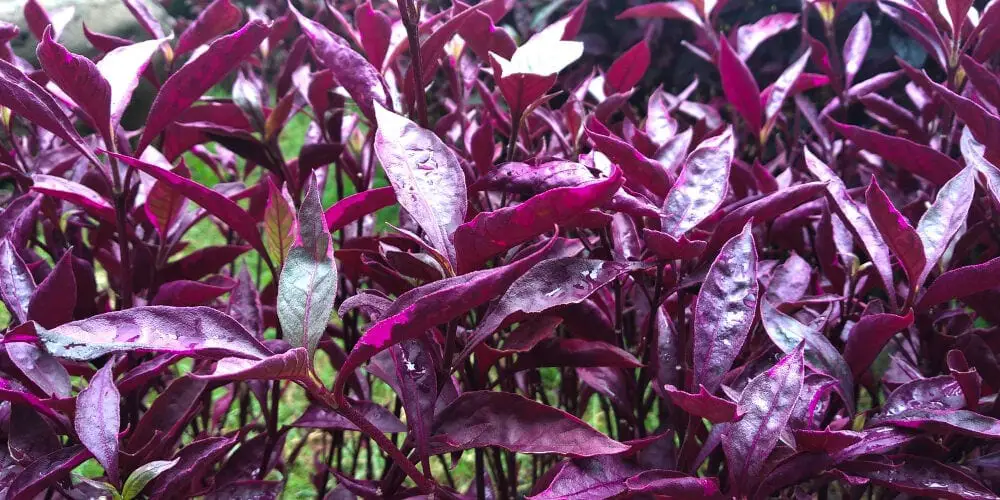The Alternanthera plant boasts some great looking foliage that would make for an excellent addition to any garden.
You’ll quickly find that this plant don’t require a high level of care, which is great if you are very busy. Regardless of what you already have in your garden, you should consider this plant.
Alternanthera Plant Care & Growing Guide
1. Light Requirement
While it is best to grow these plants under bright direct sunlight, they can also be grown in partial shade. If you are growing this plant outside, you should choose a spot that receives direct light. If you are growing it inside a greenhouse, choose a spot by a window that gets lots of bright sunlight.
2. Water
You’ll need to make a point of keeping the soil your plant is in nice and moist all the way around. It is important that you do not allow the soil to dry out altogether, as this can do irreversible damage to the plant.
You should give the plant a little bit of extra water when it is particularly dry outside. The soil should be moist up to four inches down after you have watered it.
If you are growing this plant indoors, you’ll need to make sure that the top inch of soil is dry before watering it. Take the saucer out after you water the plant to ensure that it drains properly.
3. Climate
The Alternanthera plant can be grown as an annual in every single USDA hardiness zone except for 10 and 11.
4. Soil
These plants are not fussy when it comes to the type of soil they are grown in, provided it is well-draining and kept moist.

5. Temperature
Alternanthera plants can withstand temperatures from 55 to 65 degrees Fahrenheit. If the plant is young and matured, you should wait until the frost is gone to put it in the ground. It is important that you give these plants a rest when it comes to winter.
During the winter months, you’ll want to stop using fertilizer and water it less. You should allow the first couple of inches of soil to get dry before you water it during this time of year. While the plant will keep growing, it will do so very slowly.
6. Repotting
When repotting your Alternanthera, you’ll first want to make certain that it is not rootbound. If this is the case, you’ll want to use a flat tool to carefully separate the roots from the ball. This can be tricky, so you need to be gentle.
Choose a container that is about twice as large as the current one when repotting. This will ensure that the entire root system will have adequate room to spread out.
7. Speed of Growth
This plant can grow up to 12 inches in a single year, so you’ll need to be prepared.
8. Height and Spread
Some varieties of the Alternanthera plant can grow up to 20 inches tall with a spread of 36 inches. You’ll want to leave at least 18 inches between these plants when you put them in the ground.
9. Flowers
Certain species of this plant produce green flowers, while others have white ones. Alternanthera dentate can be grown as an annual in colder areas and a perennial in tropical climates. These plants typically bloom in early to mid summer.
10. Trimming
When you want to encourage new growth in your Alternanthera plant, you’ll want to prune it back to three or four inches from the soil. You only want to do this when warm weather is right around the corner. If the winter months in your area are mild, you can do this in February or March.

Can Alternanthera Grow in Water?
You will be able to grow this plant in either soft or hard water without much effort. It is idea to grow it in water that is mildly acidic. Make sure that you keep the temperature of the water between 75 and 80 degrees Fahrenheit.
How to get Alternanthera to Flower
The most effective way for you to get your Alternanthera plant to flower is to keep it in well-drained soil. You also need to make sure that it gets bright direct sunlight all day long. When these plants are kept in partial shade, they don’t tend to bloom fully or as well.
Common Alternanthera Plant Diseases
The biggest problem that these plants have is with root rot or loss of leaf color, which is usually due to it being in the wrong soil. If your plant’s soil doesn’t drain very well, it can develop all sorts of very serious problems.
Some people find that their Alternanthera plants take on an undesirable shape. This is not due to disease or pests, but rather a lack of pruning. These plants grow quickly, so you need to stay on top of trimming if you want to keep them nice and shapely.
You might find that spider mites or caterpillars are attracted to your plant. You’ll just want to take them off by hand. These pests can cause a lot of damage if they are not kept in check, so you need to keep that in mind.
Conclusion
- The Alternanthera plant needs lots of bright direct sunlight to grow properly.
- It is important to keep the soil your plant is in nice and moist.
- Do not allow the soil to dry out completely, as this can cause irreversible damage to the plant.
- This plant can be grown in all USDA hardiness zones except 10 and 11.
- A temperature range of 55 to 65 degrees Fahrenheit is best for these plants.
- You can grow this plant in just about any type of soil, provided it is well-draining.
- These plants can grow up to 20 inches tall with a maximum spread of 36 inches.
- You should keep a minimum distance of 18 inches between these plants.
- Some of these plants produce while flowers, while others produce green ones.
- The best way to get this plant to flower is by watering it regularly and providing it with lots of direct sunlight.
Victoria is the owner and main author of hobby plants. She loves spending her free time in her garden planting and taking care of her plants. Victoria hopes you enjoy the content here!